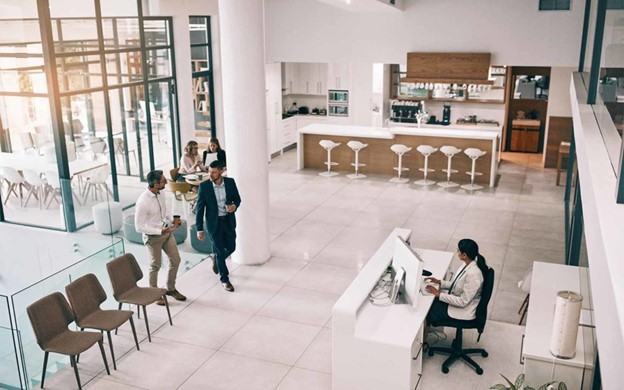
Many businesses that adopt a hybrid work model have some form of ‘hot desking’ arrangement in place. Creating a dedicated space where everyone can book a desk is often an effective solution to capacity issues when the numbers working onsite can vary day to day. With the adoption of easy booking apps, hot desking can also offer employees greater certainty, knowing that a desk is available to them when visiting the office. Employees don’t feel they have to arrive early at the office just to get a good spot. Instead, they arrive already knowing they have a desk waiting for them.
Providing certainty
With hot desking comes the issue of hygiene. By that we don’t mean personal hygiene but the state of a desk that will be used by various people throughout the week.
Just how various? Hot desking is different than having a shared desk. For example, the person who works at reception in the morning sits at a desk by the front entrance. Later in the afternoons, a different person sits at the same desk. But with a hot desking area, employees don’t know who used the desk before them nor who will use it after. There’s some uncertainty there, but a good hygiene policy helps everyone feel confident that no matter who came before them, the desk is clean.
On top of simple peace of mind, why is desk hygiene important? There’s always cold season to think about in winter and seasonal allergies in spring. The rest of the time, there’s usual something “going around.” An awareness of the need for clean, healthy offices helps keep everyone healthy and productive.
If you want to create an office space that employees look forward to visiting, then you need to allay their fears and also provide them with experience that doesn’t require them to clean up the mess left behind by the desk’s previous user. They should be confident and certain that their interests and health are important considerations.
In short, a clean desk is essential both before and after it is used by another colleague. What should you be thinking about to make that happen and what other measures should you consider to ensure your hot desking programs are safe and encourage people to visit the office?
Tips for hot desking hygiene
- Distance hot desks
Although many organizations used to keep desks apart for social distancing, there are many other reasons it makes good sense to keep them separated.
Distance offers both safety and a sense of security. At roughly six feet apart, people are still close enough to collaborate but without having to worry about spreading or catching colds. For some offices, this may require new floor plans and some strategic thinking about how to position your desks. You may also want to put a limit on overall capacity in your hot desking space. It’s best not to have the desks too close together, creating a working environment that may be too close for comfort for some.
Distance also provides the quiet space many need to focus deeply on their work. By adding enough room between desks, you’re making space for workers to concentrate. According to recent research, the most common office disruption is a nearby coworker conversation.
- Stagger shifts and schedules
Another way you can avoid crowding is by being flexible about when people can use your hot desks, and good desk scheduling software allows you to limit the use of your hot desk area throughout the day. That’s a plus for hygiene and a natural extension of a flexible work policy where not everyone is following the traditional 9-5 workday.
- Allow time for cleaning
Create a time cushion between desk changeovers for a thorough cleaning. Allow sufficient time for a robust cleaning protocol, ideally with a system for hot desk disinfection. It may take just a few minutes, or you may want to add a little more time to account for any unforeseen complications, but make sure that the gap between bookings is there.
- Make it easy to be hygienic
Give colleagues the tools they need to clean their own desks and, for example, sanitize their hands. Personal hygiene stations should be made available on desks and around wider spaces. Is there disinfectant for everyone to use? The easier it is for someone to see the products, the more likely they are to use them.
Many are still in the habit of carrying hand sanitizer and wipes, but having ample supplies at the ready ensures everyone has what they need. It can also be helpful to post some signs, so people know where to find cleaning products. Those signs do double duty as reminders for people to wipe down their desks when they’re ready to leave.
Just as important as the supplies is the knowledge of how and where to clean a hot desk. If you’re asking employees to give the workstation a quick wipe down before they start and once they’re done, ask them to focus on the surfaces that people tend to touch most, including the computer and any peripherals like the mouse. In many cases, though, workers bring their own laptops, so they only need to wipe down the top of the desk and any parts of the chair that came into contact with their hands, including the armrests.
If you’re creating instructions for janitorial staff, ask them to “clean first, sanitize second.” They should remove any visible dirty with a clean cloth before applying disinfectant.
It’s not just one room

It’s important to remember that hygiene issues around hot desking don’t just apply to the area where the physical desks are based. Many people who are hot desking will need to use other parts of your office such as kitchens, shared meeting spaces, printers and photocopier rooms, entrances, exits and restrooms. Your hygiene policies should also cover these additional areas.
It’s especially important to focus on shared surfaces. So, a good hygiene program encourages people to wipe down the touchscreen on the photocopier and the table in the breakroom, for example.
Keep it clean
Hygiene in the office has always been an important issue. Once even a simple cold takes hold, it can quickly move from person to person, sapping productivity. But now with more organization adopting the hybrid work model and effective flexible working, workers are sharing more spaces and equipment than before. By taking some simple, solid steps, you can keep it clean and make everyone keen to visit your workplace.



